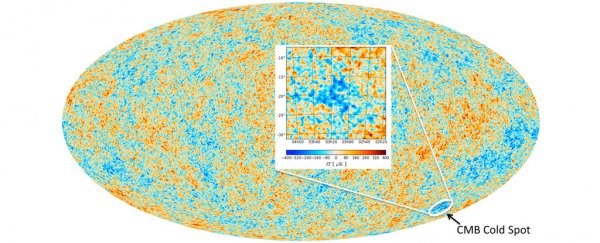It's called the 'Cold Spot': an unusually cool region in the background radiation that has lingered throughout the Universe since just after the Big Bang.
That radiation blanket is called the cosmic microwave background (CMB), and while it's full of subtle temperature variations, the Cold Spot has nonetheless remained a frigid mystery to scientists, who haven't been able to explain just why this one spot is consistently colder than its surroundings.
The deviation – measuring 0.00015 degrees Celsius (0.00027 degrees Fahrenheit) cooler than its surroundings – has previously led scientists to propose that the Cold Spot could be due to a massive supervoid thought to stretch some 1.8 billion light-years across, from which an estimated estimated 10,000 galaxies or so are missing.
That would make it the largest such void of its kind, composed of around 20 percent less matter than the rest of the Universe, but according to a new study led by astronomers at Durham University in the UK, the Cold Spot might not be because of a supervoid after all.
Using the Anglo-Australian Telescope, the team surveyed the redshifts of 7,000 galaxies, charting light sources moving away from Earth as the Universe expands.
With this new data set, they say that there is no supervoid capable of explaining the Cold Spot within standard cosmological theory.
Instead of a supervoid devoid of galaxies, they suggest the Cold Spot is instead made of a bunch of smaller voids, which are themselves surrounded by clusters of galaxies.
Likening the structure of this mesh to a foam of 'soap bubbles', they say the overall density of matter in the smaller voids (taken in conjunction with the galaxy clusters) ends up being about the same as the density found elsewhere in the Universe outside the Cold Spot.
"The voids we have detected cannot explain the Cold Spot under standard cosmology," says one of the team, Ruari Mackenzie.
"There is the possibility that some non- standard model could be proposed to link the two in the future but our data place powerful constraints on any attempt to do that."
The researchers estimate there is about a one-in-fifty chance that the Cold Spot may have arisen due to random variations under standard cosmology – but outside that, they say we may have to look for a more 'exotic' explanation of how the Cold Spot came to be.
"Perhaps the most exciting of these is that the Cold Spot was caused by a collision between our Universe and another bubble universe," explains one of the team, astronomer Tom Shanks.
This idea of the multiverse – in which our Universe exists in its own bubble, simultaneously as other parallel universes exist within their own – only exists in the realm of theory for now.
But scientists are always on the lookout for weird evidence in the Universe that could hypothetically support the concept – and fluctuations in the CMB are often cited as an example.
That said, the researchers here acknowledge that there's no direct evidence in their results to support such a case – but they point out that now that the supervoid has been outed as a possibility, it tilts the balance in favour of other kinds of explanations, even if they're unusual.
"If further, more detailed, analysis of CMB data proves this to be the case," says Shanks, "then the Cold Spot might be taken as the first evidence for the multiverse – and billions of other universes may exist like our own."
In other words, right now we still don't know how the Cold Spot got there for sure – but learning more about it and the CMB in general could throw the lid open on a whole lot of amazing science, and we can't wait to find out.
The findings are reported in Monthly Notices of the Royal Astronomical Society.
